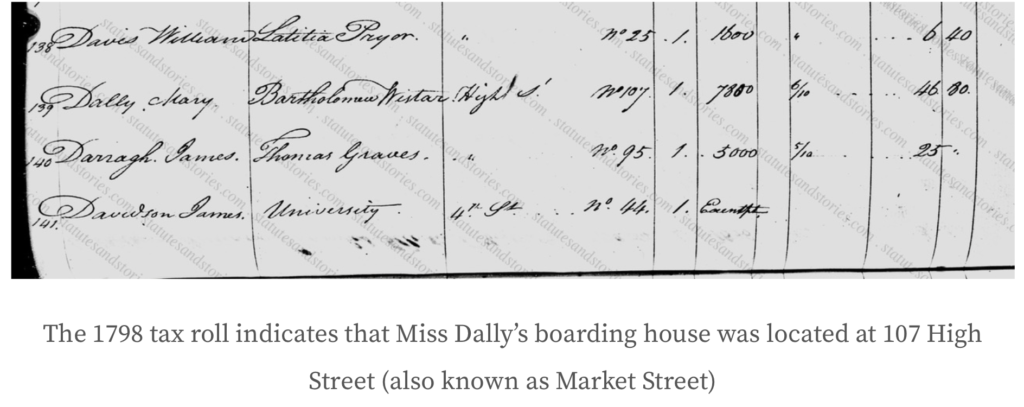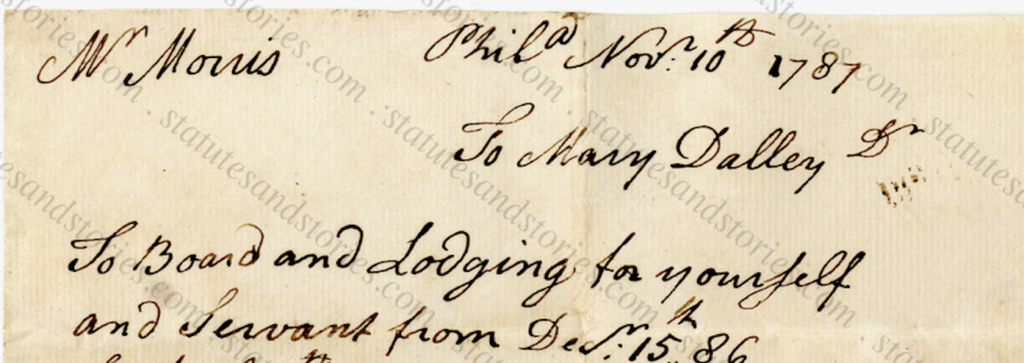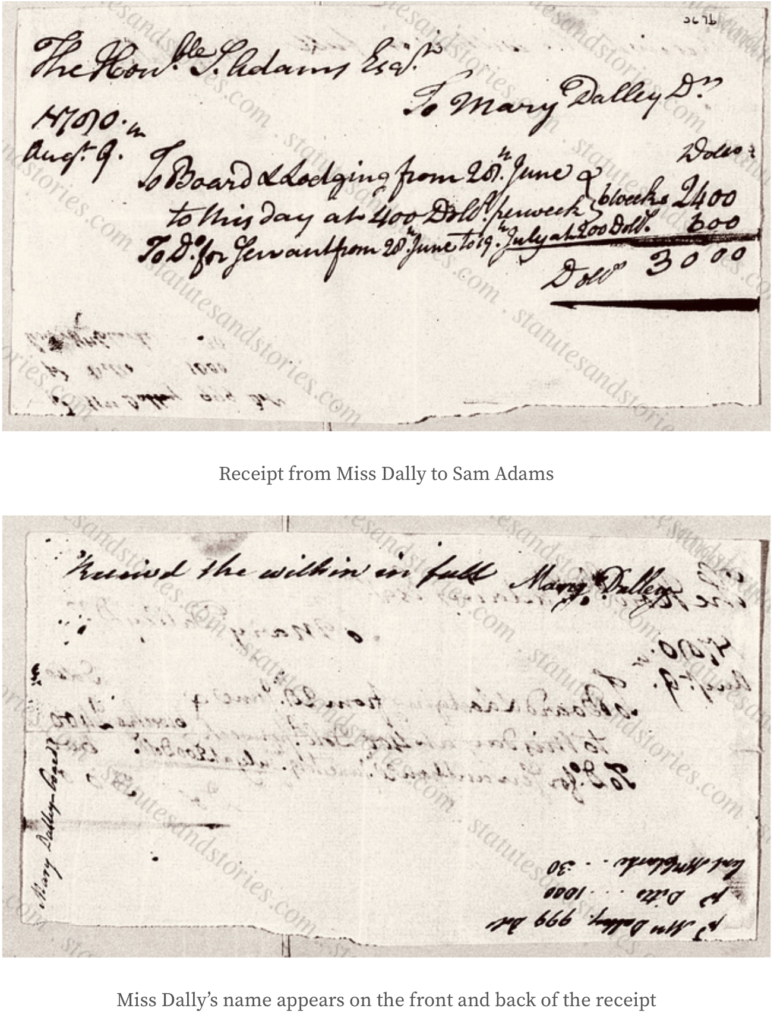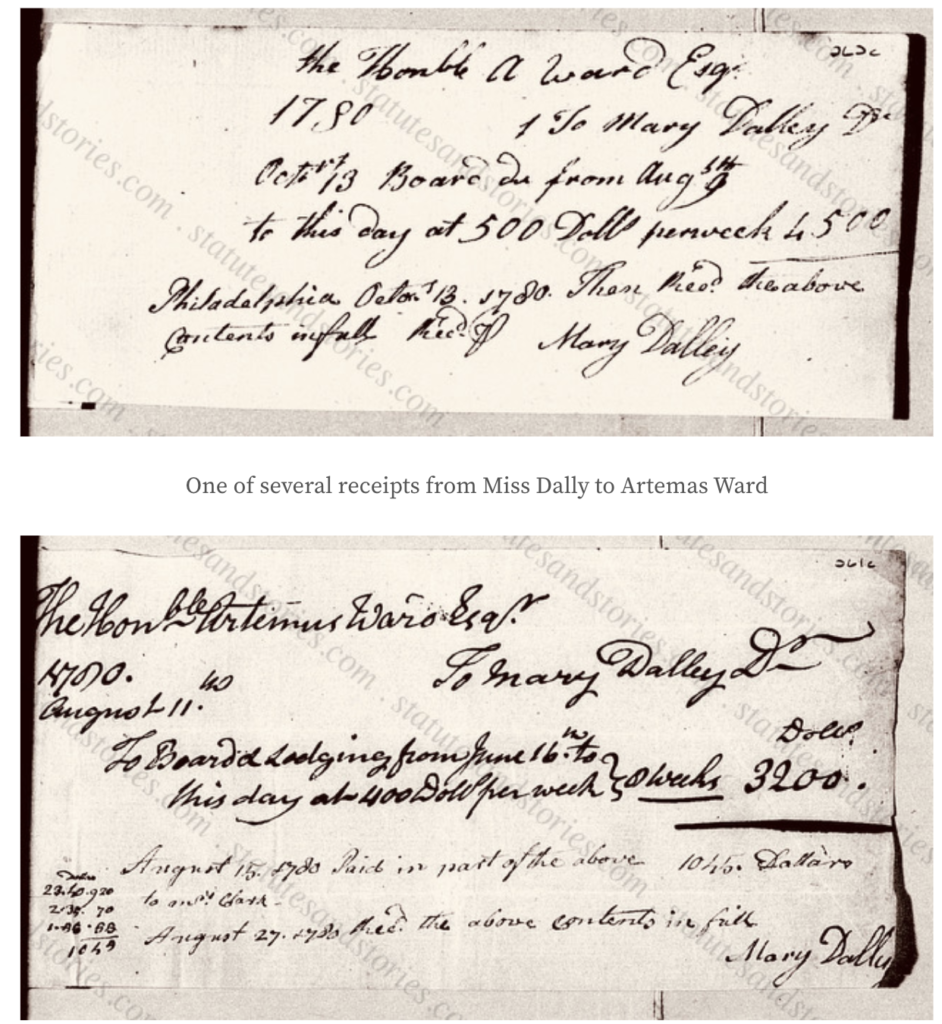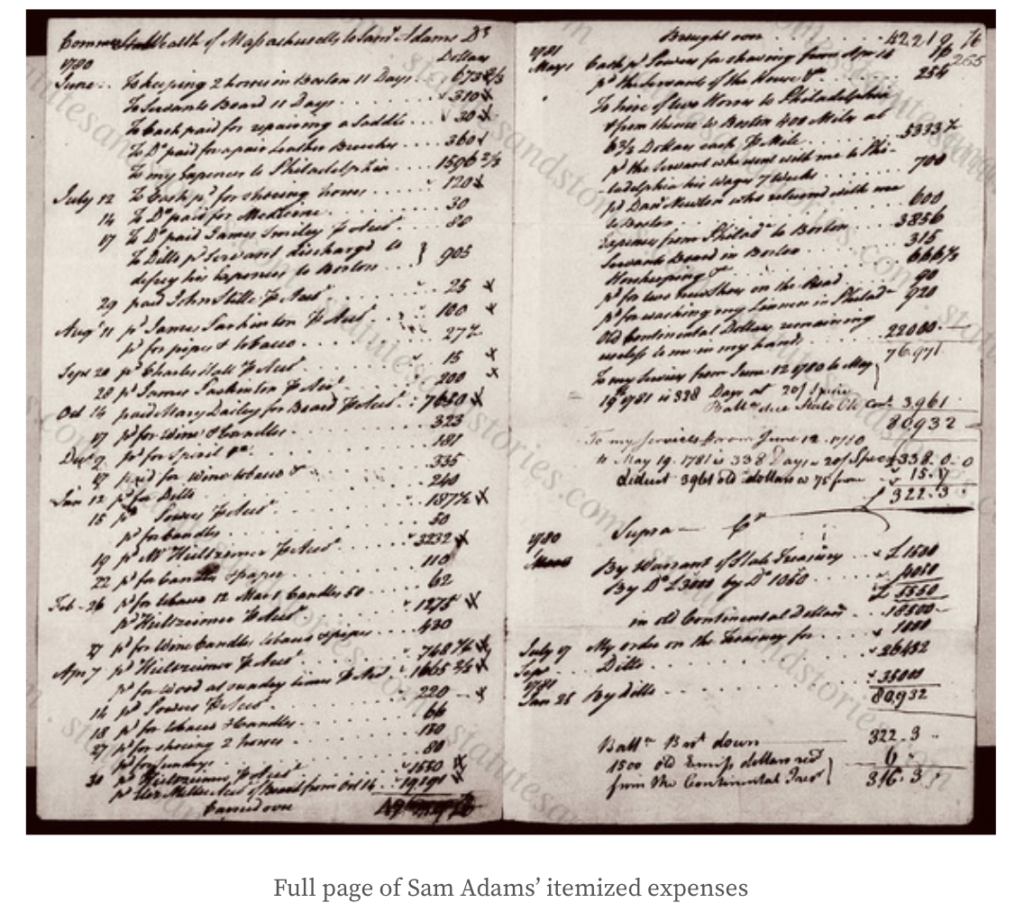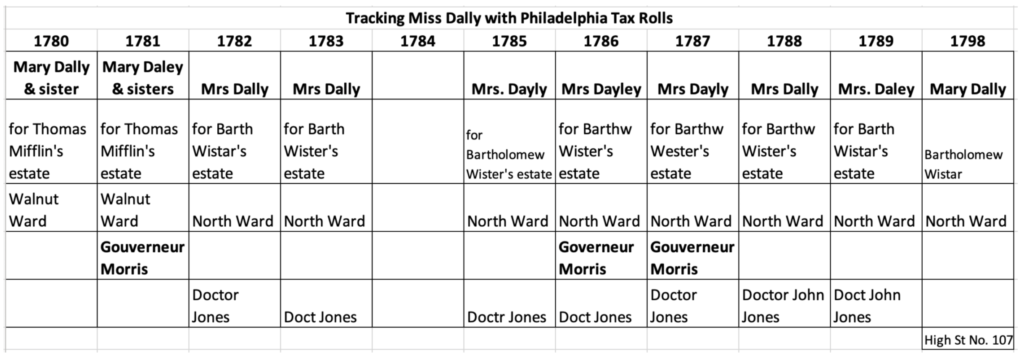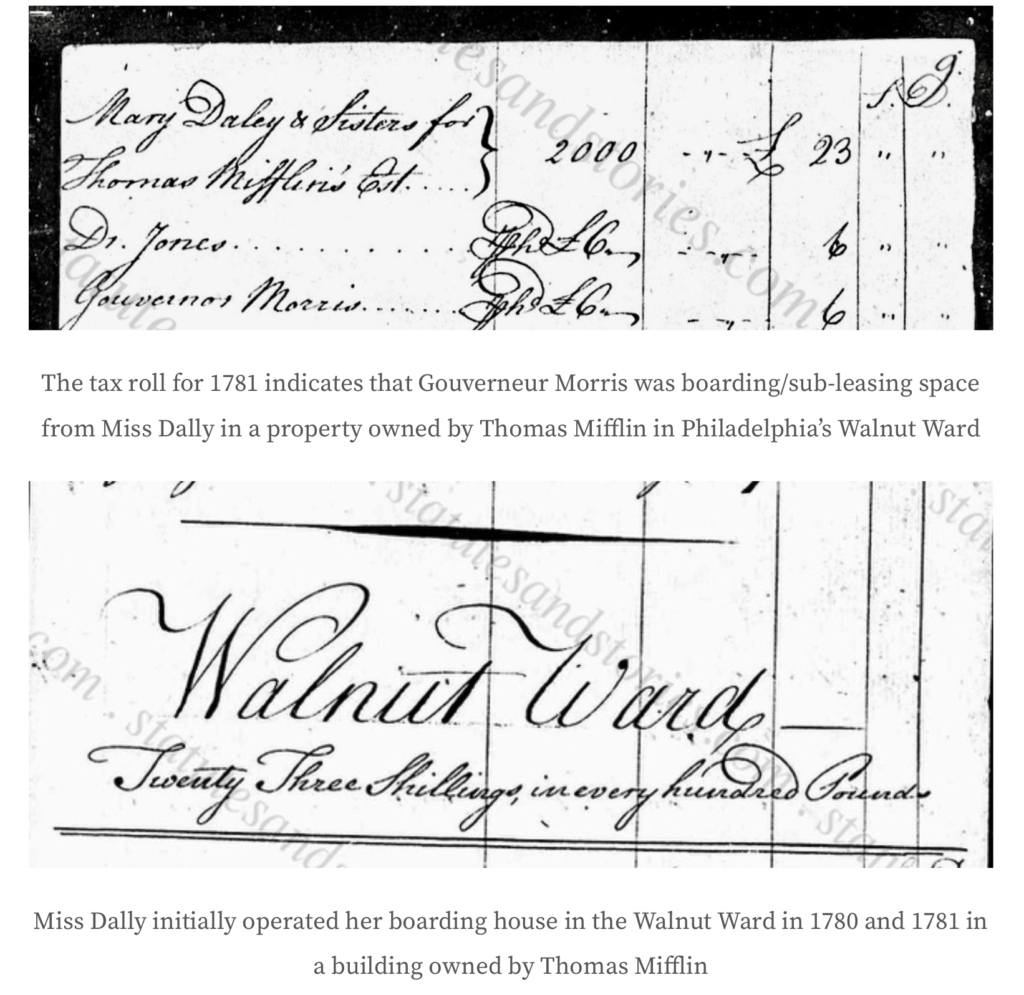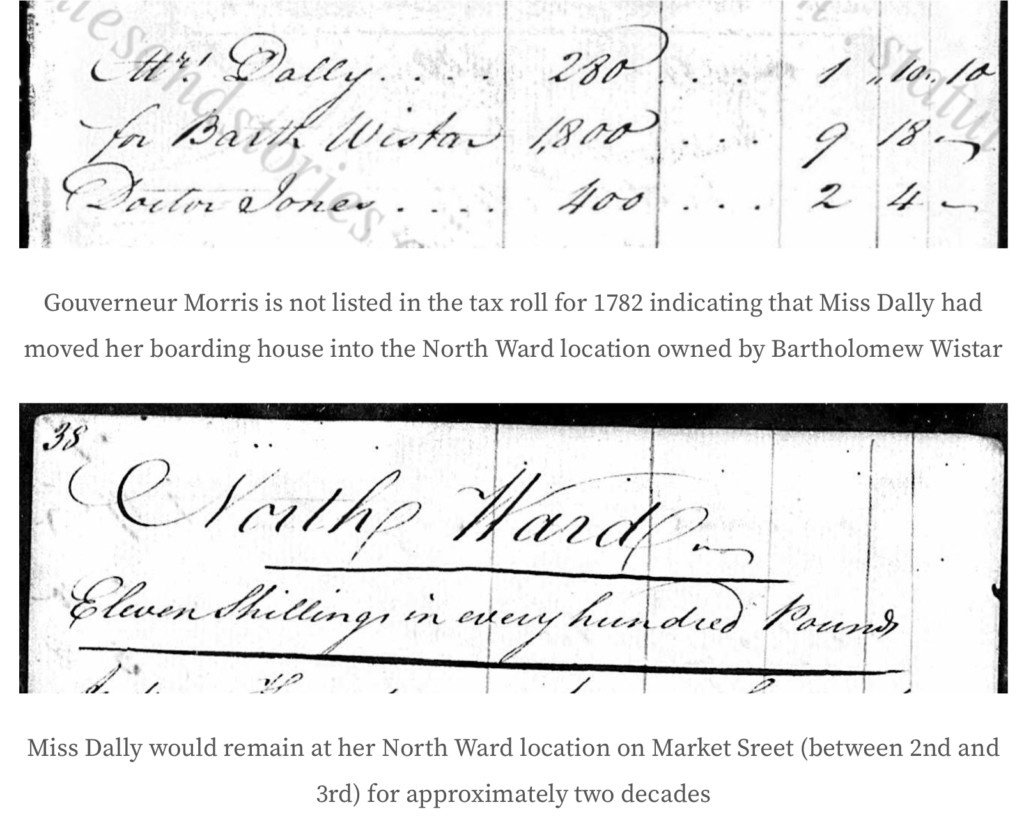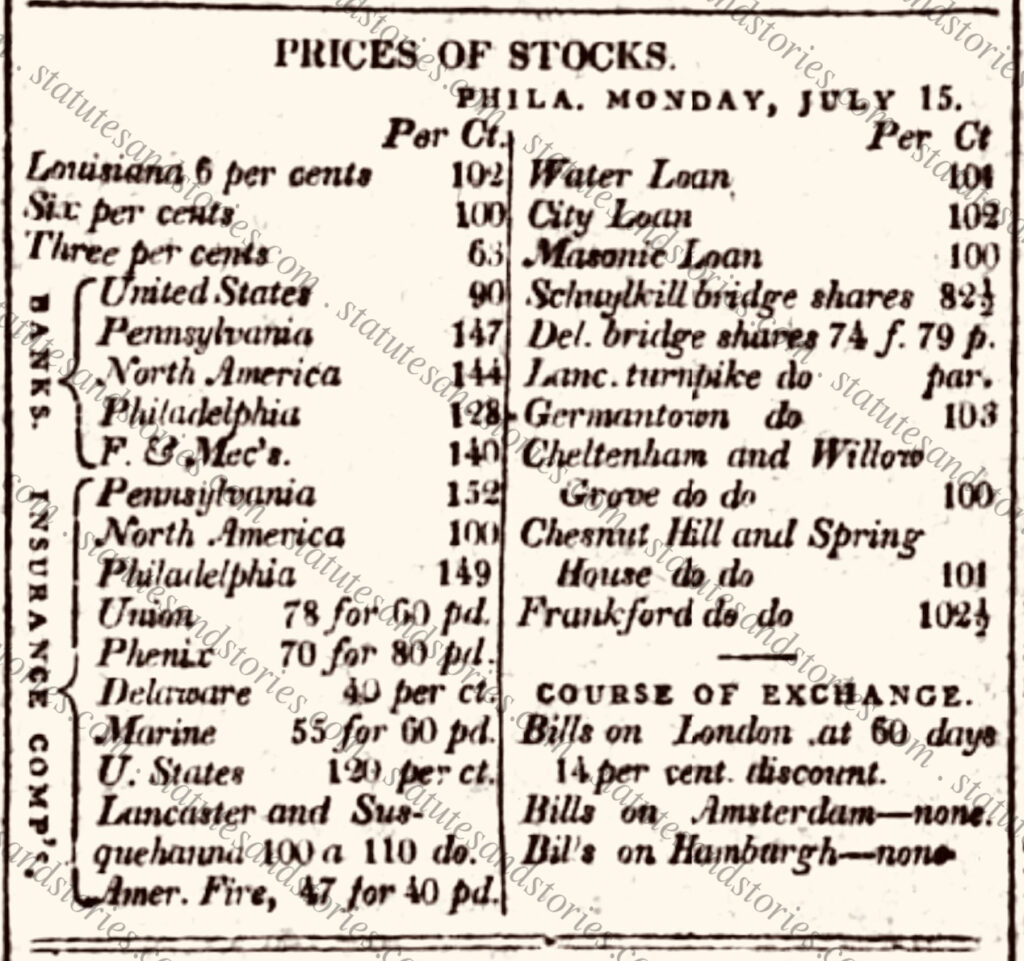America’s Founding Hosts
The First Family of Hospitality (The Dalley/Fraunces/Simmons family)
Part 2 – Mary Dalley’s Boarding House
Although largely forgotten today, Mary Dalley was well known by some of the most famous signers of the Declaration of Independence and the Constitution. The name Mary Dalley[1] begins appearing in the letters of delegates to Congress in 1778, when Samuel Adams and the Massachusetts delegates to the Continental Congress routinely boarded with Miss Dalley and her sister, Miss Clark.[2] A decade later, Gouverneur Morris, Elbridge Gerry and Alexander Hamilton boarded with Miss Dalley during the Constitutional Convention.
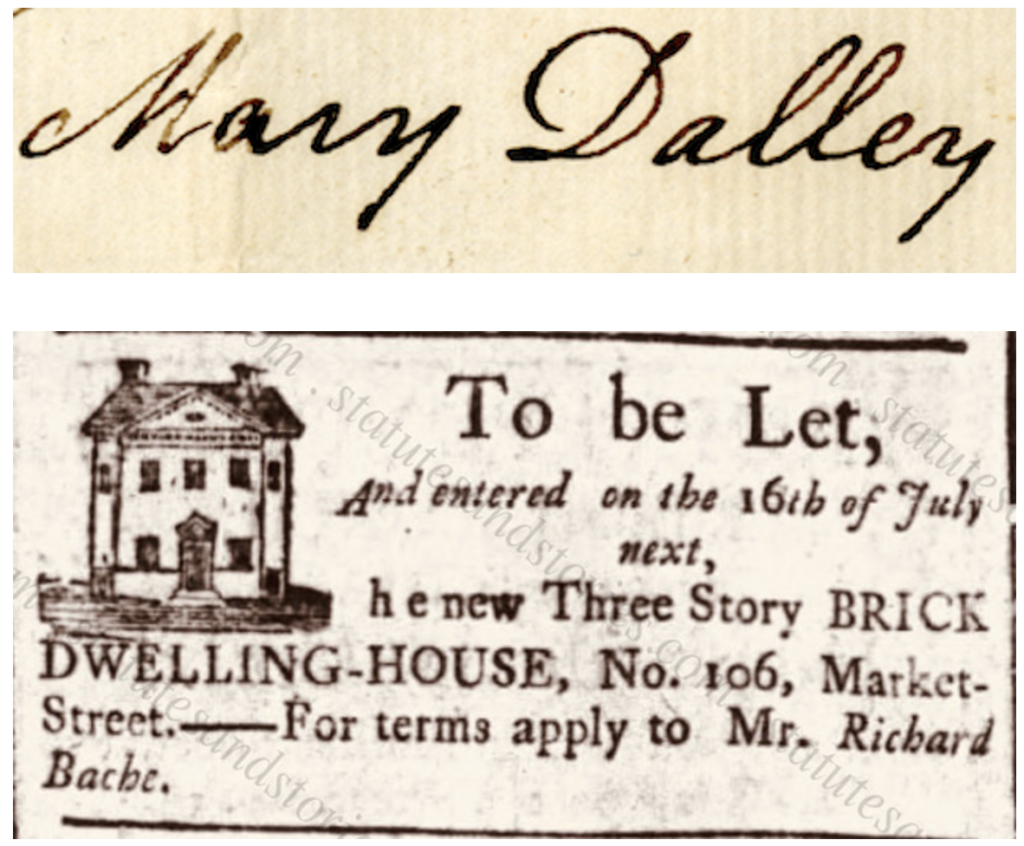
Gouverneur Morris is widely regarded as the “penman” of the Constitution. Until recently, the location where Morris boarded during the summer of 1787 was an open question. Two hundred and thirty-six years later, following an exhaustive review of archival records, it can be safely concluded that Gouverneur Morris was boarding with Miss Dalley when he was selected by the Committee on Style and Arrangement to prepare the final draft of the Constitution.
Regrettably, Mary Dalley’s enormously important boarding house has largely been forgotten. Unlike the well-known “Declaration House” where Thomas Jefferson resided during the summer of 1776, there are no historical markers commemorating Miss Dalley or her boarding house. This is unfortunate as the location where Gouverneur Morris resided in 1787 is likely the site where Morris “drafted” the Preamble and the September 12th draft of the Constitution. As described in a series of blog posts on StatutesandStories.com, newly discovered evidence helps piece together Miss Dalley’s untold story. A historic marker application has been submitted to the State of Pennsylvania to honor Miss Dalley. It also turns out that Miss Dalley has a remarkable story to tell in her own right. Click here for a link to the pending application to install a historic marker at or near the corner of Market and Third Street in Philadelphia, the location where Miss Dalley catered to the founding generation for two decades.
This post is the second in a multi-part series about the extended Dalley/Fraunces/Simmons family, who operated some of the most important boarding houses and taverns in the late 18th Century. America’s Founding Hosts – Part 1 discusses brother Gifford Dalley who was the doorkeeper to the 1st, 2nd, and 3rd Congress when he wasn’t operating City Tavern, the Merchants’ Coffee House or Dalley’s Hotel in Philadelphia.
Two other Dalley sisters, Catherine and Elizabeth, operated famous taverns in New York. Sister Catherine Dalley married John Simmons, who operated Simmon’s Tavern located at 63 Wall Street near City Hall in Manhattan. Elizabeth Dalley married Samuel Fraunces, the proprietor of Fraunces’ Tavern famously located at 54 Pearl Street in Manhattan. Samuel Fraunces also served as the steward of President Washington’s household in New York and Philadelphia. Simmon’s Tavern is discussed in Founding Hosts – Part 3. Fraunces’ Tavern is discussed in Founding Hosts – Part 4 (pending). Genealogical records of the Dalley/Simmons/Francis/Fraunces family and as yet unanswered questions for future researchers will be discussed in Founding Hosts – Part 5 (pending).
“Liberty Hall”
Miss Dalley’s boarding house first comes to life in a remarkable series of letters between New Hampshire Congressional delegate William Whipple and Virginia delegate Richard Henry Lee. The “Whipple – Lee correspondence” illustrates the deep friendships that were forged around Miss Dalley’s hearth. Massachusetts delegates to Congress, including Samuel Adams, began boarding with Miss Dalley during the Revolutionary War, as early as 1778.

Upon his return to Congress in 1778 after the Battle of Saratoga, New Hampshire delegate William Whipple wrote to Richard Henry Lee that he had “taken my quarters at Liberty Hall.”[3] The extraordinary correspondence between Whipple and Lee demonstrates that Miss Dalley’s boarding house was affectionately known as Liberty Hall. Richard Henry Lee likely created the label “Liberty Hall” to refer to the location where Samuel Adams, the “Patriarch of Liberty,”[4] boarded with the Massachusetts delegates to Congress in the late 1770s.
The social scene at Miss Dalley’s boarding house was described in Whipple’s 8 November 1778 letter to Lee:
I have taken up my quarters at Liberty Hall where you know is a set, well agreed in political sentiments and I think I may say with great certainty that they are well agreed in sentiments of esteem and respect for you. I anticipate the pleasures of some long winter evenings where with a social pipe and friendly glass we shall call to mind our worthy friend and heartily join in wishing he may soon add to our little circle.
Lee replied to Whipple on 29 November 1778 indicating that he venerated Liberty Hall and the “sociable evenings” that its inhabitants spent there:
I venerate Liberty Hall, and if I could envy its present inhabitants anything it would be the sensible sociable evenings they pass there. I have not yet been able to quit the entertainment of my prattling fireside, when I have when I heard every little story and settled all points, I shall pay a visit to Williamsburg where our Assembly is now sitting.
Lee concluded the November 29th letter by asking Whipple to “[r]emember me with affection to the Society at Liberty Hall…”[5] Similarly, in a letter to Samuel Adams dated 6 June 1779, Lee extended “[m]y best respects to the patriotic inhabitants of Liberty Hall, and to my esteemed friends Gen. Whipple, Mr. Sherman, General Spencer & Mr. Ellery. I am and shall remain whilst I live your friend.”[6]
Miss Dalley’s name first appears in the historic record in the diary of Massachusetts delegate Samuel Holten in July of 1778.[7] Holten noted that “I removed from Wid[ow] Robinson’s, to board at the house of Miss Dalley & Miss Clark in 2[nd] street.” In a letter dated 13 December 1778, Samuel Adams wrote to his wife Betsy that “Mrs. Clark and her sister Miss Daily in whose house the Massachusetts delegates are agreeably situated present their respectful complements to you.”

Because the Dalley family lived in the New York/New Jersey area prior to the Revolutionary War, it is likely that the family relocated to Philadelphia when the British captured Manhattan in 1776. As was not uncommon for mobile tavern/boarding house operators, Miss Dalley moved operations from an initial location on Second Street in Philadelphia to a house owned by General Thomas Mifflin[8] on Front Street.[9] Coincidentally, Gouverneur Morris and Thomas Mifflin would serve together as delegates at the Constitutional Convention in 1787. It is unclear why Miss Dalley moved out of the Mifflin property. Yet, by 1782 Miss Dalley had relocated to what would become her permanent address at 107 Market Street.[10]
According to property tax rolls pictured below, the 107 Market Street location where Miss Dalley operated in the 1780s and 1790s was owned by Bartholomew Wistar. The building measured 3,570 square feet and consisted of one dwelling house and four “out houses” which may have been used as law/medical offices by Gouverneur Morris and doctor John Jones. Beginning in 1789 Miss Dalley also operated a tea shop, selling several varieties of imported tea from China.
While Miss Dalley operated her boarding house/tea shop for approximately two decades, she did not own the building. Nevertheless, the Philadelphia tax rolls make clear that Miss Dalley paid the annual real estate tax on behalf of the owner, Bartholomew Wister. Mr. Wister was a prominent Quaker who was elected to the Pennsylvania Society for Promoting the Abolition of Slavery in April of 1787. Ben Franklin, his grandson William Temple Franklin, and Thomas Paine were also elected to the Society in April of 1787, the month before the Constitutional Convention met in Philadelphia. According to James Madison’s notes, Gouverneur Morris was an outspoken opponent of slavery at the Constitutional Convention, referring to slavery as a “nefarious institution” and “the curse of heaven on the states where it prevailed.” It is thus no surprise that Gouverneur Morris would board with Miss Dalley.
Boarding House of the “Penman of the Constitution”
The historic record has become clear that during the summer of 1787 Gouverneur Morris (the “Penman of the Constitution”) boarded with Miss Dalley.[11] As described above, when Samuel Adams and the Massachusetts delegates to Congress boarded with Miss Dalley a decade earlier, her boarding house was known as “Liberty Hall.” It is thus appropriate that Gouverneur Morris boarded at “Liberty Hall” when he “drafted” the Preamble on behalf of the Constitutional Convention’s Committee of Style and Arrangement between September 8th to September 12th.
During the past several years StatutesandStories.com conducted wide-ranging archival research regarding Miss Dalley’s boarding house. Historians have long suspected that Gouverneur Morris boarded with Miss Dalley during the Constitutional Convention. Using Gouverneur Morris’ bank records at the Library of Congress, it is now possible to confirm that Morris began boarding/sub-letting space with Miss Dalley in the early 1780s. Click here for a discussion of Gouverner Morris’ banking records evidencing payments to Miss Dalley beginning in 1781. Click here for a discussion of the receipt pictured below from Miss Dalley to Gouverneur Morris providing further definitive proof that Gouverneur Morris boarded with Miss Dalley during the Constitutional Convention in 1787.
Philadelphia tax rolls likewise demonstrate that Gouverneur Morris was a long-term tenant of Miss Dalley’s in the building owned by Bartholomew Wistar. Click here for a discussion of the tax rolls which confirm the fact that Gouverneur Morris boarded with Miss Dalley in 1786 and 1787. Following the Constitutional Convention Gouverneur Morris departed Philadelphia for New York, to begin residing in his newly acquired estate in Morrisania. Click here for a discussion of the protracted probate litigation which concluded with Gouverneur Morris’ purchase of the Morrisania estate from his brother, Staats Long Morris, a British major general and member of Parliament. Click here for a discussion of Alexander Hamilton’s involvement in the Morris family litigation and loyalist claim involving the Morrisania estate.
As far as can be determined, Miss Dalley did not leave behind any personal correspondence or memoirs. Scholars of the Constitutional Convention have understandably focused on the fifty-five delegates who assembled in Philadelphia between May and September of 1787. Nevertheless, clues about Miss Dalley and her sister, Miss Clark, emerge from the correspondence of her famous boarders who lived together as an extended “family” for months at a time. In particular, perennial Massachusetts delegate Elbridge Gerry boarded with Miss Dalley dating back to 1778 when he was attending Congress. Click here for a discussion of letters sent by Elbridge Gerry to his wife Ann during the Constitutional Convention indicating that Alexander Hamilton and Elbridge Gerry both boarded with Miss Dalley at various times during the Constitutional Convention in 1787.
The Graaf House, the location where Thomas Jefferson drafted the Declaration of Independence, was described in a letter written by Jefferson years after the fact.[12] By contrast, Gouverneur Morris never addressed the location where he drafted the Constitution. Nevertheless, in 1814 Morris eventually admitted “[t]hat instrument was written by the fingers, which write this letter.”[13]
Years later, James Madison – the only remaining framer still alive at the time – acknowledged Gouverneur Morris’ handiwork drafting the Constitution on behalf of the Committee on Style and Arrangement:
The finish given to the style and arrangement of the Constitution, fairly belongs to the pen of Mr. Morris; the task having, probably, been handed over to him by the Chairman of the Committee, himself a highly respectable member, and with the ready concurrence of the others. A better choice could not have been made, as the performance of the task proved.[14]
Based on newly emerging evidence it is reasonable to theorize that the Committee on Style operated out of Miss Dalley’s boarding house between September 8 to September 12 (hereinafter the “Committee on Style Venue Hypothesis”). While admittedly there is no direct documentary evidence for the Committee on Style Venue Hypothesis, the growing body of circumstantial evidence suggests that Miss Dalley’s boarding house was the most convenient, central location for the Committee on Style to meet when drafting the all-important September 12 draft of the Constitution, which included the Preamble. Click here for a discussion of the Committee on Style Venue Hypothesis.
Receipts and expense reports dating back to 1779
It is abundantly clear that members of the Massachusetts delegation to the Continental Congress began boarding with Miss Dalley and her sister, Miss Clark, as early as 1778. Copied below are detailed receipts and Congressional expense reports prepared by Massachusetts delegates Samuel Adams, Artemas Ward, and Samuel Holten. These primary sources document payments to Miss Dalley and were submitted to the Massachusetts Comptroller’s Office to obtain reimbursement by Adams, Ward and Holten for their Philadelphia expenses. These primary sources were located in the Massachusetts State Archives and help flesh out Miss Dalley’s story along with other primary sources pictured below.
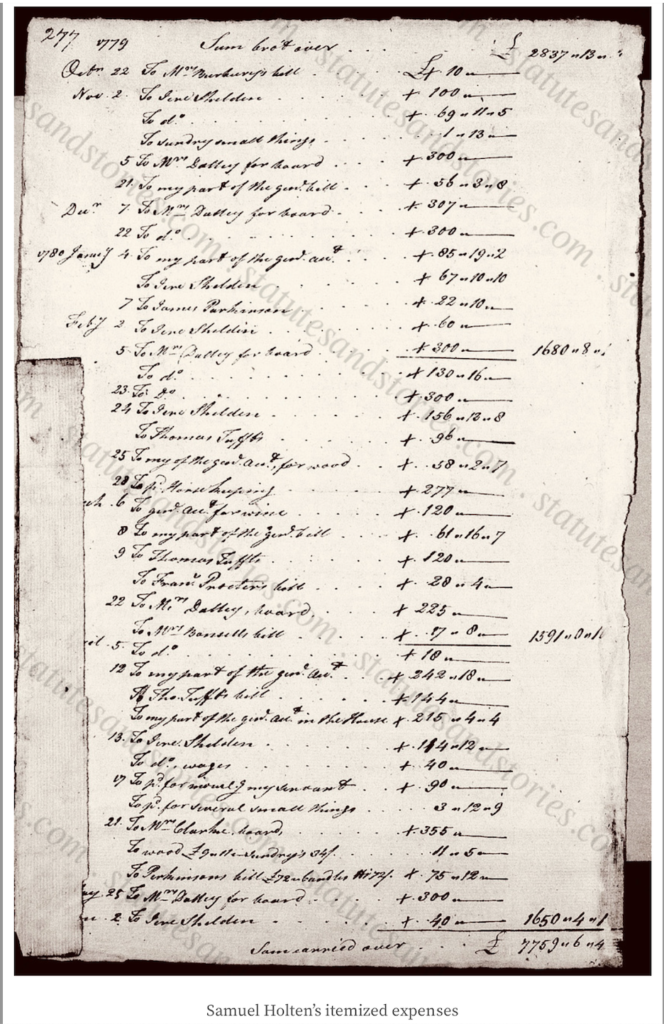
Philadelphia tax records
In addition to expense reports and receipts, Mary Dalley’s name also repeatedly appears in the Philadelphia tax rolls. In 1780 Miss Dalley and her unnamed “sisters” operated their boarding house in a building they rented from Thomas Mifflin. As illustrated in the following chart, the Mifflin property was located in the Walnut Ward where Miss Dalley operated her boarding house for approximately two years in 1780 and 1781.
The tax roll for 1781 indicates that Gouverneur Morris was boarding/sub-leasing space from Miss Dalley in a property owned by Thomas Mifflin in Philadelphia’s Walnut Ward. Circa 1782 Miss Dalley relocated from the Walnut Ward property owned by Thomas Mifflin to the 107 Market Street location in the North Ward owned by Bartholomew Wistar. Miss Dalley would remain at her 107 Market Street address for approximately two decades.
The tax roll for 1787 further confirms the conclusion that Gouverneur Morris boarded with Miss Dalley during the Constitutional Convention. Philadelphia tax rolls establish that Gouverneur Morris boarded/rented space from Miss Dalley in 1781, 1786 and 1787.
Other clues about Miss Dalley
Although it does not appear that any of Miss Dalley’s personal correspondence has been preserved, it is possible to reconstruct her story using a variety of other primary sources. In particular, street directories, newspaper advertisements, and her last will and testament are set forth below. Her close relationship with long-time tenant Doctor John Jones also becomes clear in the correspondence of Doctor John Jones and Elbridge Gerry.
Francis White’s Philadelphia directory was published in 1785. It is noteworthy that Miss Dalley is listed as a “taylor.”[15] Her sister, Mrs. Clark, is described as operating a “boarding house.” The same location – Market Street between Second and Third – is listed as the address for “Dally Mary,” “Clark Mrs.” and long-term boarders “Morris Governeur” and “Jones, John M.D.”
Another of Miss Dalley’s famous tenants was Dr. John Jones who has been called the “father of American surgery.” Jones was the first professor of surgery in the new world, where he helped establish the medical school that would become Columbia University. Prior to the American Revolution, Jones wrote the first medical text published in America. Jones’ surgical field manual was used throughout the Revolutionary War.
In a colorful letter dated September 20, 1785 to Elbridge Gerry, Dr. Jones shared useful details about Miss Dalley and her sister.[16] Dr. Jones summarizes news from Philadelphia and mentions that he was responding to a letter from Gerry, which suggests that the two were in regular correspondence.
At the end of the September 1785 letter Jones mentions Mrs. Clark’s cooking, indicating that “Mrs. Clark says she wishes you was [sic] here” to enjoy her “rumps of Philadelphia beef.” The sense of humor by both Mrs. Clark and Dr. Jones is remarkable, suggesting a degree of familiarity that would only be expected among close friends and family. Dr. Jones concludes the letter by adding that “Miss Dally wishes you were as well as ever.” Taken together, these details help confirm the conclusion that Miss Dalley, her sister Mrs. Clark, Doctor Jones and Elbridge Gerry shared longstanding friendships developed over years of living together in the same household.
Importantly, the September 20 letter from Dr. Jones provides insights into Miss Dalley’s political thinking. Doctor Jones explains that Miss Dalley:
is so much absorbed in the cares of her shop, and in such bad spirits at the dullness of the times, that like poor Guillaume on the Farce, she sometimes despairs of the safety of poor America.
The letter ends with Jones relaying that Miss Dalley and Mrs. Clark desire to send their best wishes for your health and happiness.
Given that this may be the only extant example of Miss Dalley’s “politics” it is useful to deconstruct the letter. Doctor Jones compares Miss Dalley to the merchant Guillaume Joceaulme (“Guillaume”) from the famous French tragedy, La Farce of Master Pathelin (“La Farce”). Doctor Jones studied in France prior to the Revolutionary War, earning a medical degree from the University of Rheims. This may explain his familiarity with La Farce, in which Guillaume was forced to deal with both dishonest suppliers and customers.[17] Presumably this same difficulty confronted Miss Dalley. This may partially explain why Miss Dalley was “so much absorbed in the cares of her shop.”

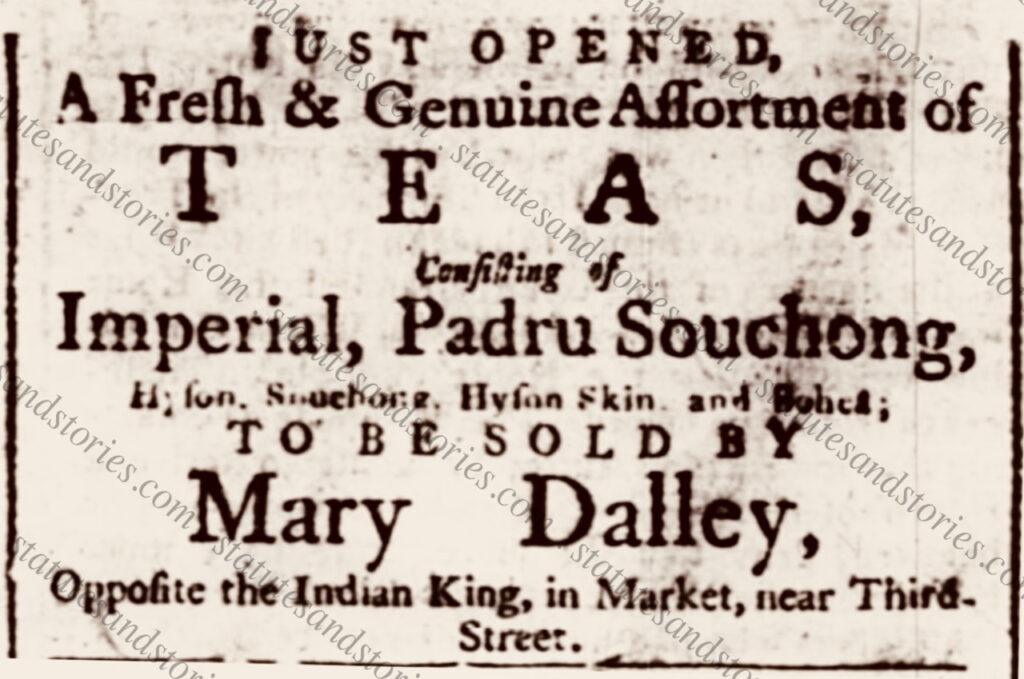
It is unclear, however, why Miss Dalley was in “such bad spirits at the dullness of the times.” Rather than referring to a “dull” social scene in Philadelphia, it is entirely possible that the “dullness of the times” referred to the economic conditions in 1785. Perhaps the most intriguing information in the letter is the statement that Miss Dalley “sometimes despairs of the safety of poor America.” If indeed Miss Dalley was despairing over the economic and political status of America, one can infer that she might have been supportive of the Federalists who would write the Constitution two years later. The fact that Miss Dalley was expressing opinions about the “safety” of America similarly suggests that she was an active participant in political discussions taking place in her boarding house in 1785.
In a letter dated 30 May 1787 Elbridge Gerry mentions both Miss Dalley and her “bespoke” tea. Gerry writes that “I am in the same Family in which I have lived, when here, since the year 1778.” This sentence makes clear that in May of 1787 Gerry returned to Miss Dalley’s boarding house during the Constitutional Convention in the same household where he regularly boarded since 1778 as a delegate to Congress from Massachusetts. The advertisement pictured above contains an announcement that Miss Dalley opened her tea shop in June of 1789, the same year that the new federal government began operations. Philadelphia would serve as the nation’s capital for ten years from 1790 until the year 1800, when Washington, D.C. became the new capital.

Miss Dalley’s will from 1811 is also instructive. Mary designates “my sister Catherine Simmons” as her first named and largest beneficiary. Presumably, Mary’s sisters Mrs. Clarke and Elizabeth Fraunces were no longer alive in 1811. Her brother Gifford Dalley passed in 1798 during a Yellow Fever outbreak in Philadelphia. Miss Dalley is buried in Christ Church in Philadelphia alongside her nephew John B. Simmons. [18]
Miss Dalley’s stock holdings are also noteworthy. According to her will she owned shares of the Bank of North America and the Schuylkill Bridge Company. Sample stock quotes in 1811 are pictured below, including the Bank of North America and the Schuylkill Bridge Company.
The Schuylkill Permanent Bridge was the first covered bridge in America. Completed in 1805, it spanned the 550-foot length of the Schuylkill River using a series of arches. With a total length of 1,300 feet the bridge connected High Street/Market Street to Philadelphia’s western suburbs. [19]
This post continues in Part III which will discuss sister Catherine Dalley Simmons (Simmons’ Tavern). Sister Elizabeth Dalley Fraunces (Fraunces’ Tavern) will be discussed in Part IV (pending). Genealogical records of the Dalley/Simmons/Francis/Fraunces family and as yet unanswered questions for future researchers will be discussed in Part V (pending).
Endnotes
[1] Primary sources variously spell the family name as Dally, Dalley, Dailey, Dayley, and Daley. Based on the discovery of receipts signed by Miss Dalley, it is clear that she preferred the spelling Dalley, which is used in this post.
[2] Miss Dalley’s boarders included Massachusetts delegates Samuel Adams, Elbridge Gerry, Artemas Ward, and Samuel Holten.
[3] William Whipple to Richard Henry Lee, 8 November 1778, Letters of Delegates to Congress, ed. Paul H. Smith (1985), 11:187-188.
[4] When drafting his Inaugural Address Thomas Jefferson asked himself, “is this exactly in the spirit of the patriarch of liberty, Samuel Adams? Is it as he would express it? will he approve of it?” Letter dated 29 March 1801 from Thomas Jefferson to Samuel Adams.
[5] The Letters of Richard Henry Lee, ed. James Curtis Ballagh (1914), I:453-455.
[6] The Letters of Richard Henry Lee, ed. James Curtis Ballagh (1914), II:59-61.
[7] Letters of Delegates to Congress, ed. Paul H. Smith (1983), 10:344. Holten’s diary indicates that “General Whipple came to board with us” on 5 November 1778.
[8] Thomas Mifflin would be elected the first Governor of Pennsylvania in 1790 after ratification of the Constitution. During the war he served as an aide-de-camp to General Washington. Before the war Mifflin served in the First Continental Congress. He returned to Congress in 1782 and was elected the third President of Congress in 1783. Richard Beeman, Plain, Honest Men (2009), 191; Carol Berkin, A Brilliant Solution: Inventing the American Constitution (2002), 229.
[9] On 23 July 1779 Holten indicated that “Mrs. Clark & Dalley & all her boarders moved from 2d Street to Front Street, to General Mifflin’s house.” Letters of Delegates to Congress, ed. Paul H. Smith (1986), 13:154.
[10] Under the early street number system proposed in 1785 by John MacPherson’s Directory for the City and Suburbs of Philadelphia Miss Dalley’s address was 311 Market. Under the street numbering system pioneered by Charles Biddle Miss Dalley’s address was 107 Market Street (also known as “High Street”). The Encyclopedia of Greater Philadelphia, Andrew Heath, “Street Numbering” https://philadelphiaencyclopedia.org/essays/street-numbering/
[11] Gouverner Morris’ banking records evidencing payments to Miss Dalley beginning in 1781. Property tax rolls indicate that Gouverneur Morris was living in the same building with Miss Dalley. Removing any remaining doubt, a signed receipt from Miss Dalley to Gouverneur Morris provides definitive proof that Gouverneur Morris boarded with Miss Dalley during the Constitutional Convention.
[12] Thomas Jefferson to James Mease, 16 September 1825. https://founders.archives.gov/documents/Jefferson/98-01-02-5539
[13] Gouverneur Morris to Timothy Pickering, 22 December 1814. https://babel.hathitrust.org/cgi/pt?id=hvd.32044013690680&view=1up&seq=433
[14] James Madison to Jared Sparks, 8 April 1831. https://founders.archives.gov/documents/Madison/99-02-02-2323
[15] In a letter dated 1 September 1787 Elbridge Gerry mentions that he would ask Miss Dalley to assist with the purchase of silk for the Gerry family. James Hutson, Supplement to Max Farrand’s Records of the Federal Convention of 1787 (1987), 254. Miss Dalley’s expertise with fabric makes sense as she was listed as a tailor in Francis White’s 1785 Philadelphia Directory.
[16] As best as can be determined, the 20 September 1785 letter from Doctor Jones to Elbridge Gerry is in private hands. It was previously included in the Sang Collection, which was sold in five installments between 1978 to 1981. Fortunately, select manuscripts and/or copies of letters in the Sang Collection were retained at various institutions including Southern Illinois University, the University of Chicago, Brandeis and Yale. Periodically, letters from the Sang Collection reappear in auction catalogs.
[17] Through the use of flattery, the lawyer Pathelin convinces Guillaume — against his better judgment — to sell cloth on credit. The fact that Dr. Jones is comparing Miss Dalley to the character Guillaume is interesting on several levels. Miss Dalley not only sold tea and operated a boarding house, she was also a tailor. Indeed, Elbridge Gerry sought her expertise regarding fabric in 1787. It is also significant that she is being compared to a male merchant, which arguably suggests that Miss Dalley could hold her own.
[18] Edward L. Clark, A Record of Inscriptions on the Tablets and Grave-Stones in the Burial Grounds of Christ Church, Philadelphia (1864), 209.
[19] Thomas Paine, the famous author of Common Sense, presented plans for the construction of an iron bridge across the Schuylkill. In 1798 Paine’s proposed plans were rejected in favor of a less expensive design by bridge architect Timothy Palmer. https://collaborativehistory.gse.upenn.edu/stories/bridging-schuylkill-early-mid-19th-century#:~:text=The%20Permanent%20Bridge%20opened%20to,feet%20long%20in%20total%20construction.&text=The%20Permanent%20Bridge%20facilitated%20expanding,engulfed%20and%20destroyed%20by%20fire.

